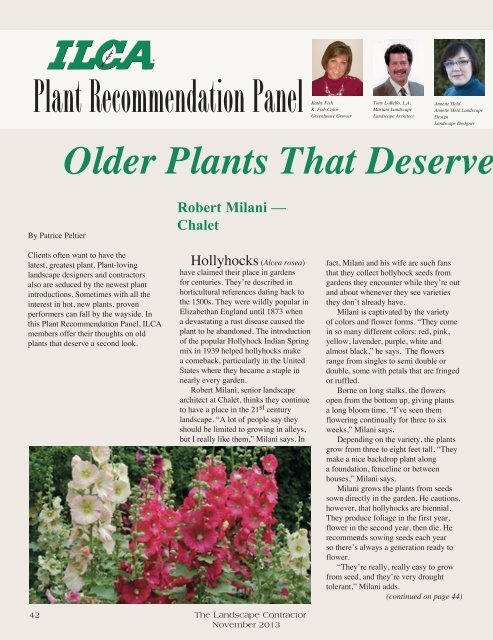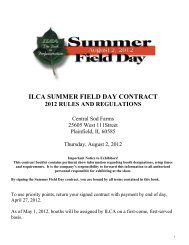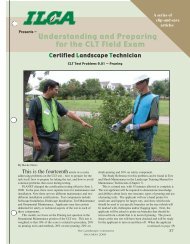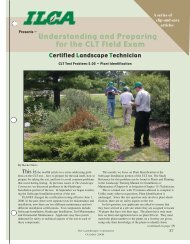Plant Recommendation Panel
read - Illinois Landscape Contractors Association
read - Illinois Landscape Contractors Association
Create successful ePaper yourself
Turn your PDF publications into a flip-book with our unique Google optimized e-Paper software.
<strong>Plant</strong> <strong>Recommendation</strong> <strong>Panel</strong><br />
Kathy Fish<br />
K. Fish Color<br />
Greenhouse Grower<br />
Tony LoBello, L.A.<br />
Mariani Landscape<br />
Landscape Architect<br />
Annette Held<br />
Annette Held Landscape<br />
Design<br />
Landscape Designer<br />
Abby L<br />
Claren<br />
Compa<br />
Floral<br />
Older <strong>Plant</strong>s That Deserve a<br />
By Patrice Peltier<br />
Clients often want to have the<br />
latest, greatest plant. <strong>Plant</strong>-loving<br />
landscape designers and contractors<br />
also are seduced by the newest plant<br />
introductions. Sometimes with all the<br />
interest in hot, new plants, proven<br />
performers can fall by the wayside. In<br />
this <strong>Plant</strong> <strong>Recommendation</strong> <strong>Panel</strong>, ILCA<br />
members offer their thoughts on old<br />
plants that deserve a second look.<br />
Robert Milani —<br />
Chalet<br />
Hollyhocks (Alcea rosea)<br />
have claimed their place in gardens<br />
for centuries. They’re described in<br />
horticultural references dating back to<br />
the 1500s. They were wildly popular in<br />
Elizabethan England until 1873 when<br />
a devastating a rust disease caused the<br />
plant to be abandoned. The introduction<br />
of the popular Hollyhock Indian Spring<br />
mix in 1939 helped hollyhocks make<br />
a comeback, particularly in the United<br />
States where they became a staple in<br />
nearly every garden.<br />
Robert Milani, senior landscape<br />
architect at Chalet, thinks they continue<br />
to have a place in the 21 st century<br />
landscape. “A lot of people say they<br />
should be limited to growing in alleys,<br />
but I really like them,” Milani says. In<br />
fact, Milani and his wife are such fans<br />
that they collect hollyhock seeds from<br />
gardens they encounter while they’re out<br />
and about whenever they see varieties<br />
they don’t already have.<br />
Milani is captivated by the variety<br />
of colors and flower forms. “They come<br />
in so many different colors: red, pink,<br />
yellow, lavender, purple, white and<br />
almost black,” he says. The flowers<br />
range from singles to semi double or<br />
double, some with petals that are fringed<br />
or ruffled.<br />
Borne on long stalks, the flowers<br />
open from the bottom up, giving plants<br />
a long bloom time. “I’ve seen them<br />
flowering continually for three to six<br />
weeks,” Milani says.<br />
Depending on the variety, the plants<br />
grow from three to eight feet tall. “They<br />
make a nice backdrop plant along<br />
a foundation, fenceline or between<br />
houses,” Milani says.<br />
Milani grows the plants from seeds<br />
sown directly in the garden. He cautions,<br />
however, that hollyhocks are biennial.<br />
They produce foliage in the first year,<br />
flower in the second year, then die. He<br />
recommends sowing seeds each year<br />
so there’s always a generation ready to<br />
flower.<br />
“They’re really, really easy to grow<br />
from seed, and they’re very drought<br />
tolerant,” Milani adds.<br />
(continued on page 44)<br />
42 The Landscape Contractor<br />
November 2013
e<br />
Abby Lydon<br />
Clarence Davids &<br />
Company<br />
Floral Designer<br />
Jim Broccolo<br />
Clesen Wholesale<br />
Grower<br />
Tom Trayser<br />
The Brickman Group<br />
Robert Milani<br />
Chalet<br />
Roy Klehm<br />
Beaver Creek Nursery<br />
<strong>Plant</strong>sman<br />
Jeff Gibson<br />
Ball Horticultural Company<br />
Lisa Fiore-Kositzki, L.A.<br />
Don Fiore Co., Inc.<br />
Landscape Architect<br />
Charlie Keppel<br />
The Care of Trees<br />
Tree Care Expert<br />
a Second Look<br />
Alcea rosea<br />
The Landscape Contractor 43<br />
November 2013
Older <strong>Plant</strong>s That Deserve a<br />
(continued from page 43)<br />
For a shrub with great multi-season<br />
interest, Milani recommends taking a<br />
second look at Nanking cherry (Prunus<br />
tomentosa). Native to Japan and China,<br />
the plant was introduced in the U.S. in<br />
1892. A densely twiggy shrub, it grows<br />
six to 10 feet high and wide. In spring its<br />
pink buds open to fragrant, white flowers<br />
followed by red, cherry-like fruits.<br />
The bark is shiny, reddish brown and<br />
exfoliating.<br />
Drought tolerant, Nanking cherry<br />
grows in full sun in well drained soil.<br />
“It’s very dependable and very colorful,”<br />
Milani says. “It’s a plant that definitely<br />
deserves a second look.”<br />
When it comes to finding<br />
replacements for ash trees, Milani also<br />
looks to the past for a tough tree that has<br />
stood the test of time: Northern Catalpa<br />
(Catalpa speciosa).<br />
Native to southern Illinois and<br />
Indiana, northern catalpa has been in<br />
cultivation since 1754. Because it is<br />
tolerant of a wide variety of soils, both<br />
wet and dry conditions and air pollution,<br />
Milani thinks this tree is a good choice<br />
for urban conditions.<br />
The tree grows 40-60 feet tall and<br />
20-40 feet wide with a narrow, open,<br />
irregular crown. In May through June, the<br />
tree produces four to eight-inch long coneshaped<br />
panicles of white, tubular flowers.<br />
Those big flowers produce big seedpods<br />
that range from 8 to 20 inches long. The<br />
seedpods are green, maturing to brown<br />
and often persisting through winter. “They<br />
can be messy,” Milani admits.<br />
The medium green, heart-shaped<br />
leaves grow six to 12” long and three<br />
to eight inches wide. In autumn, leaves<br />
turn yellow-green, often falling before<br />
changing colors. The tree is hardy in<br />
Zones 4 to 8.<br />
RICK!!! Please give photo credit for the<br />
Catalpa and the Nanking cherry to The<br />
Morton Arboretum.<br />
Catalpa speciosa<br />
44 The Landscape Contractor<br />
November 2013<br />
Prunus tomentosa
a Second Look<br />
Annette Held —<br />
Annette Held Landscape Design<br />
“I use Spiraea vanhouttei<br />
for older houses because it was a plant<br />
that was common way back when,” says<br />
Annette Held of Annette Held Landscape<br />
Design in Chicago. “I have recollections<br />
of seeing them in many of my aunt’s<br />
gardens growing up and up against old<br />
Victorians and farm houses.”<br />
A cross between two Chinese<br />
species—S. cantoniensis and S. trilobata-<br />
-Spiraea x vanhouttei was developed in<br />
France in 1862. It was named for Louis<br />
VanHoutte, a Belgian horticulturist, who<br />
is credited with popularizing the plant.<br />
Before long, it was a hit in the United<br />
States. The 1888 Burpee catalog devotes<br />
half a page to the plant, saying “This<br />
rare variety is the most showy of all the<br />
Spireas, and one of the very best shrubs<br />
in cultivation.” It was widely used in<br />
the United States for years. Blooming in<br />
mid-spring, its long, flower-laden whips<br />
were often used to make wreaths for<br />
brides to wear.<br />
“They have that lovely graceful<br />
arching habit and a pretty red color in the<br />
fall,” Held says. “I like them both as a<br />
specimen plant and in a massed border.”<br />
The plant grows 6-8 feet tall with a<br />
spread of 10-12 feet wide. It likes full<br />
sun, is adaptable to many soil types,<br />
hardy to Zone 3 and needs little water<br />
once established, according to Held.<br />
“They do need some room, so<br />
sometimes I like to use the newer plant<br />
Spiraea nipponica ‘Snowmound’, which<br />
is smaller, can take some shade and has<br />
a nice, blue/green foliage. Its fall color<br />
isn’t quite as nice, however.”<br />
RICK!!! Photo credit for the spiraea<br />
vanhouttei goes to The Morton<br />
Arboretum, please.
Older <strong>Plant</strong>s That Deserve<br />
Jim Broccolo —<br />
Clesen Wholesale<br />
For an overlooked annual that makes a<br />
towering statement, Jim Broccolo of Clesen Wholesale,<br />
recommends flowering tobacco, Nicotiana sylvestris.<br />
Growing up to five feet tall with a spread of up to two<br />
feet, the plant has abundant, pure white, fragrant, trumpetshaped<br />
flowers that hang from the main growing stem.<br />
“People might ordinarily be intimidated by this large annual,<br />
but it makes such a great architectural statement in the<br />
landscape,” Broccolo says.<br />
“I have seen it successfully planted in large mixed<br />
perennial beds<br />
as a dramatic<br />
summerblooming<br />
backdrop in<br />
commercial<br />
settings<br />
and parks,”<br />
Broccolo<br />
explains,<br />
adding, “Some<br />
adventurous<br />
gardeners are<br />
even planting<br />
them in<br />
oversized urns<br />
and planters<br />
for a dramatic<br />
statement.”<br />
A relative<br />
of smoking<br />
tobacco<br />
(Nicotiana<br />
tabacum),<br />
flowering tobacco was introduced into gardens in the United<br />
States and England in the 1800s. Victorian-era gardeners<br />
planted it along walkways and paths so its sweet fragrance<br />
could perfume the walks, especially in the evening when<br />
the flowers fully open and the plant is most fragrant. That’s<br />
something those of us in the 21 st century can still appreciate,<br />
and Broccolo recommends planting Nicotiana sylvestris near a<br />
patio or window.<br />
Although one of its common names is woodland tobacco,<br />
Nicotiana sylvestris tolerates full sun. Broccolo notes that<br />
it often does best getting a little afternoon shade during the<br />
hottest part of summer. The flowers conserve their energy<br />
during the peak of the day and release their fragrance in the<br />
evening.<br />
“These plants are not much to speak of in a four-inch pot at<br />
the beginning<br />
of the summer,”<br />
Broccolo<br />
admits, “but<br />
have faith,<br />
because once<br />
the summer<br />
heat kicks in,<br />
these really<br />
put on a great<br />
show!”<br />
RICK: Photo<br />
credit to<br />
National<br />
Garden Bureau<br />
46 The Landscape Contractor<br />
November 2013
e a Second Look<br />
Roy Klehm —<br />
Beaver Creek Nursery<br />
When it comes to<br />
adaptable, flowering shrubs with a<br />
past, Roy Klehm, owner of Beaver<br />
Creek Nursery, puts his money on<br />
Viburnum x juddii. “The fragrance of<br />
this older shrub easily holds its own<br />
among any newcomers,” Klehm says.<br />
A cross between V. carlesii and V.<br />
bitchiuense, V.x juddii was propagated<br />
by William H. Judd who introduced it<br />
at the Arnold Arboretum in 1920. “The<br />
fragrant, abundant white blooms that<br />
open from pink buds are Viburnum x<br />
juddii’s most outstanding feature, but<br />
handsome foliage that turns burgundy<br />
red in the fall also adds to its value in<br />
the landscape,” according to Klehm.<br />
This easily grown, dense, rounded<br />
shrub grows 5-6’ tall and 4-6’ wide.<br />
V.x juddii grows in full sun to part<br />
shade.<br />
Well-established plants are fairly<br />
tolerant of drought when mulched,<br />
Klehm says. He recommends planting<br />
this shrub near patios and walkways<br />
where the wonderful fragrance can be<br />
enjoyed.<br />
(continued on page 48)<br />
Viburnum x juddii.<br />
The Landscape Contractor 47<br />
November 2013
What are the best drought t<br />
Roy Klehm —<br />
Beaver Creek Nursery<br />
For a shade tree that deserves a second look, Klehm recommends<br />
Kentucky coffeetree (Gymnocladus dioica).<br />
Kentucky coffeetree is an Illinois native that matures to 60-75’ tall and<br />
40-50’ wide. “The tree has an attractively irregular form that makes a<br />
picturesque alternative to many of the more formal oval and round shapes of<br />
newer, cloned shade trees,” Klehm says. He also likes the outstanding, rough<br />
bark that develops at an early age.<br />
One of the latest trees to leaf out, the bipinnately compound leaves are<br />
pink-tinged when they emerge, changing to dark green in summer. Fall color<br />
is yellow.<br />
Male and female trees are separate. “Females produce<br />
brown pods that persist well into winter, adding interest to the distinctive,<br />
broadly spaced, bare winter branches,” Klehm says.<br />
“The most unique setting I have seen Kentucky coffeetree in is at the<br />
Thai Pavilion at Olbrich Botanical Gardens in Madison where this native<br />
looks amazingly palm-like and exotic,” he adds.<br />
Klehm also appreciates this tree’s adaptability. He says it’s easy to grow<br />
in typical soils, and also tolerates urban conditions, poor soils, and, when<br />
established, drought. Kentucky coffeetree is hardy in Zones 3b to 8.<br />
Photo credit to Beaver Creek Nursery, please!
t tolerant plants?
















